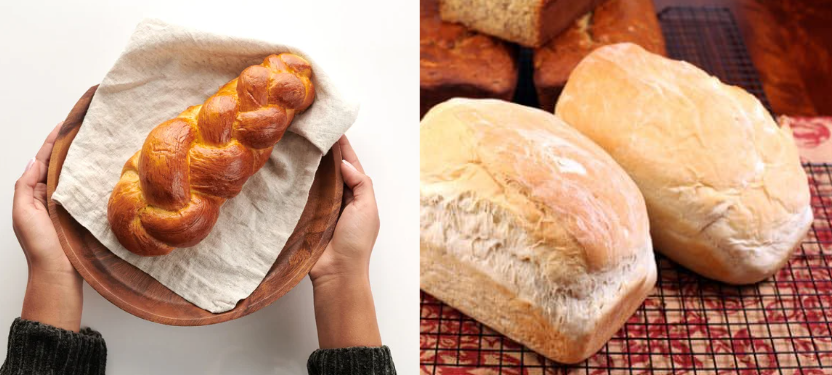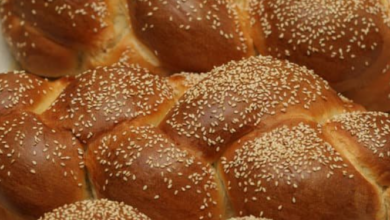Challah Vs. White Bread: How Do They Compare?

What To Know
- The absence of eggs and sugar results in a bread that is less sweet and has a more neutral taste.
- It is also commonly used in bread crumbs and as a thickening agent in soups and sauces.
- Challah offers a richer flavor and a slightly sweet taste, while white bread is characterized by its mild flavor and soft texture.
In the realm of bread making, two titans stand tall: challah and white bread. Each with its distinctive characteristics, flavor profiles, and cultural significance, these bread varieties have captivated taste buds for centuries. In this comprehensive guide, we delve into the depths of challah vs. white bread, exploring their origins, ingredients, nutritional value, and culinary applications.
Origins and History
Challah, a Jewish bread with a rich history dating back to ancient times, is traditionally braided and served during special occasions such as Shabbat and Jewish holidays. Its origins are believed to be in the Middle East, where it was considered a symbol of prosperity and abundance. White bread, on the other hand, has its roots in Europe and has become a staple in many Western cuisines.
Ingredients
Challah: Made from a combination of white flour, water, eggs, sugar, yeast, and salt, challah is characterized by its golden-brown crust and fluffy, slightly sweet interior. The addition of eggs and honey in the dough contributes to its richness and distinctive flavor.
White Bread: Typically composed of white flour, water, yeast, and salt, white bread is known for its mild flavor and soft, airy texture. The absence of eggs and sugar results in a bread that is less sweet and has a more neutral taste.
Nutritional Value
Challah: While challah is not typically considered a health food, it contains some nutrients, including carbohydrates, protein, and fiber. The presence of eggs provides a boost of protein, while the sugar and honey contribute to its higher calorie content.
White Bread: White bread is primarily composed of simple carbohydrates, providing a quick source of energy. However, it is lower in protein and fiber compared to challah and other whole-grain breads.
Culinary Applications
Challah: Challah is a versatile bread with numerous culinary applications. It is commonly used for making French toast, grilled cheese sandwiches, and bread pudding. Its slightly sweet flavor and fluffy texture make it a popular choice for breakfast and brunch dishes.
White Bread: White bread’s mild flavor and soft texture make it a popular choice for sandwiches, toast, and croutons. It is also commonly used in bread crumbs and as a thickening agent in soups and sauces.
Cultural Significance
Challah: Challah holds significant cultural importance in Jewish tradition. It is often braided into a variety of shapes, each with its own symbolic meaning. For example, the three-strand braid represents the Trinity, while the six-strand braid symbolizes the six days of creation.
White Bread: White bread has become a staple in many Western cultures, representing comfort and familiarity. Its versatility and affordability have made it a widely consumed bread around the world.
Which Bread is Better?
The choice between challah and white bread ultimately depends on personal preferences and dietary needs. Challah offers a richer flavor and a slightly sweet taste, while white bread is characterized by its mild flavor and soft texture. If seeking a more nutritious option, consider whole-grain bread varieties, which offer a higher fiber content and more complex flavor profiles.
The Bottom Line: The Bread of Choice
Whether you prefer the traditional and flavorful challah or the classic and versatile white bread, both varieties offer their own unique charms. Ultimately, the best bread is the one that satisfies your taste buds and complements your culinary creations.
Information You Need to Know
Q: Which bread has a sweeter taste?
A: Challah has a slightly sweet taste due to the addition of eggs and honey in the dough.
Q: Which bread is more versatile?
A: White bread is more versatile due to its mild flavor and soft texture, making it suitable for a wide range of culinary applications.
Q: Which bread is better for sandwiches?
A: Both challah and white bread can be used for sandwiches, but challah’s slightly sweet flavor may complement certain fillings better.
Q: Which bread is more nutritious?
A: Whole-grain bread varieties are generally more nutritious than challah or white bread, providing higher fiber content and complex flavor profiles.
Q: Can I make challah at home?
A: Yes, challah can be made at home with some practice and the right ingredients. There are numerous recipes and tutorials available online.
